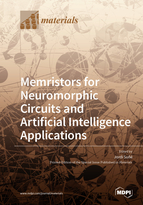Memristors for Neuromorphic Circuits and Artificial Intelligence Applications
A special issue of Materials (ISSN 1996-1944). This special issue belongs to the section "Electronic Materials".
Deadline for manuscript submissions: closed (30 November 2019) | Viewed by 63790
Special Issue Editor
Interests: resistive switching; memristors; neuromorphics; reliability; oxide electronics; non-volatile memories; electro-ionic devices; neural networks
Special Issue Information
Dear Colleagues,
Machine learning is impacting our society in every corner. This is the artificial intelligence (AI) revolution. From medical to automotive application, from preventive maintenance to global climate forecasting and prevention, from the management of emergencies to the prevention of terrorist attacks, deep-learning-based AI is continuously penetrating our daily lives. AI is a pervasive technology that, presently is mainly implemented in software. However, the solid-state nanoelectronic implementation of the memristor (for the first time in 2008 by the HP group), predicted by Prof. Leon Chua in 1971 using symmetry arguments, opens up a new frontier for AI applications: Deep learning ICs. Less-known by the general public, these hardware-based neuromeorphic systems will allow distributed energy-efficient deployment of AI in many areas requiring real-time response, intelligent decision and fast action. In this Special Issue we will try to give a general overview of this new technology. We will review the concepts of machine learning and deep learning, with a focus on their applications. We will cover the state-of-the-art technological implementation of memristor electron devices with particular emphasis on resistive devices (both ReRAM and PCM). We will also present the actual state-of-the-art of memristor-based deep learning prototypes for different applications. Finally, we will dedicate a few papers to ethical issues related to AI (and also to neurosciences). These two technologies have many potential applications that will aid to face global societal challenges (AI for the Good). However, there are also many serious ethical challenges to be faced because the coupling of these technologies have also many negative applications (AI for the Devil) that might even put the future of humanity at serious risk.
Prof. Dr. Jordi Suñé
Guest Editor
Manuscript Submission Information
Manuscripts should be submitted online at www.mdpi.com by registering and logging in to this website. Once you are registered, click here to go to the submission form. Manuscripts can be submitted until the deadline. All submissions that pass pre-check are peer-reviewed. Accepted papers will be published continuously in the journal (as soon as accepted) and will be listed together on the special issue website. Research articles, review articles as well as short communications are invited. For planned papers, a title and short abstract (about 100 words) can be sent to the Editorial Office for announcement on this website.
Submitted manuscripts should not have been published previously, nor be under consideration for publication elsewhere (except conference proceedings papers). All manuscripts are thoroughly refereed through a single-blind peer-review process. A guide for authors and other relevant information for submission of manuscripts is available on the Instructions for Authors page. Materials is an international peer-reviewed open access semimonthly journal published by MDPI.
Please visit the Instructions for Authors page before submitting a manuscript. The Article Processing Charge (APC) for publication in this open access journal is 2600 CHF (Swiss Francs). Submitted papers should be well formatted and use good English. Authors may use MDPI's English editing service prior to publication or during author revisions.
Keywords
- memristors
- artificial intelligence
- hardware-based deep learning ICs







